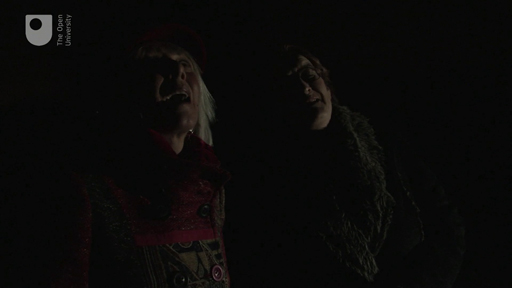1.1.2 Where is Orion?
Orion is clearly visible in the night sky from November to February. If you are in the Northern Hemisphere it is visible in the southwest sky, if you are in the Southern Hemisphere it is in the northwest sky but appears upside down.
In the following video, Monica Grady talks to Janet Sumner about finding Orion in the night sky.
Download this video clip.Video player: ou_futurelearn_orion_vid_1002.mp4


Transcript
JANET SUMNER:
So, Monica, it’s a relatively clear night in November. Shall we do some stargazing?
MONICA GRADY:
Yeah! Why not? Ok. But first thing we have to do, though, is turn our torches off--
JANET SUMNER:
OK--
MONICA GRADY:
--so we can get our eyes adjusted to the dark.
JANET SUMNER:
OK. So what are we going to look for?
MONICA GRADY:
Well, what do you know about the night sky?
JANET SUMNER:
Not a lot. There’s plenty of stars, up there. But not much more than that.
MONICA GRADY:
Do you recognise any of them, at all? Anything?
JANET SUMNER:
Um-- oh, there’s vague shapes and things, but nothing I could really pick out.
MONICA GRADY:
OK. Well, look, let’s first start off by looking at Orion. Now, he’s in the southeast part of the sky.
JANET SUMNER:
Aha. Right.
MONICA GRADY:
Which way's north?
JANET SUMNER:
Yeah, well, you told me to bring my iPhone, and I’ve got my compass up, on it.
MONICA GRADY:
Right?
JANET SUMNER:
So north is over there. So southeast is there.
MONICA GRADY:
OK. So, what can you see, in the sky, over there, then? Can you see three stars in a sort of diagonal line?
JANET SUMNER:
Yes, I can.
MONICA GRADY:
OK. That’s Orion's belt. Now, just below, there are two stars, like there and there. They’re his feet.
JANET SUMNER:
Right. One of them’s really bright.
MONICA GRADY:
Yeah, that’s right. And then, above the line, there’s two more. They’re sort of his shoulders.
JANET SUMNER:
OK.
MONICA GRADY:
OK?
JANET SUMNER:
Yeah.
MONICA GRADY:
Now, if you come back to the belt, you can see there’s some more fainter stars, coming down from the belt. And about two thirds of the way down the belt is a fuzzy patch. If you look, actually, out of the side of your eye, rather than the front of your eye, you’ll be able to see it better.
JANET SUMNER:
(LAUGHING) I feel a bit mad. Um-- yeah. Yeah. Very fuzzy patch.
MONICA GRADY:
Bit fuzzy?
JANET SUMNER:
Yeah.
MONICA GRADY:
Yeah. OK. Well, that’s called the Orion Nebula.
JANET SUMNER:
OK.
MONICA GRADY:
All right, now it’s the whole-- that's the constellation of Orion, the mighty hunter.
JANET SUMNER:
So why is he called the hunter, then?
MONICA GRADY:
Well, in Greek mythology, Orion was a hunter. And he made this really mad boast that he could kill all the animals on the earth. And this rather peeved Artemis, who is goddess of the hunt. And, well- - I mean, there were two versions. One version is, she was his lover. And the other version was that, you know, she really hated him. But whatever happened, she accidentally killed him. And so she asked Zeus, the king of the gods, to put him up in the stars.
Interactive feature not available in single page view (see it in standard view).
